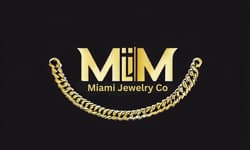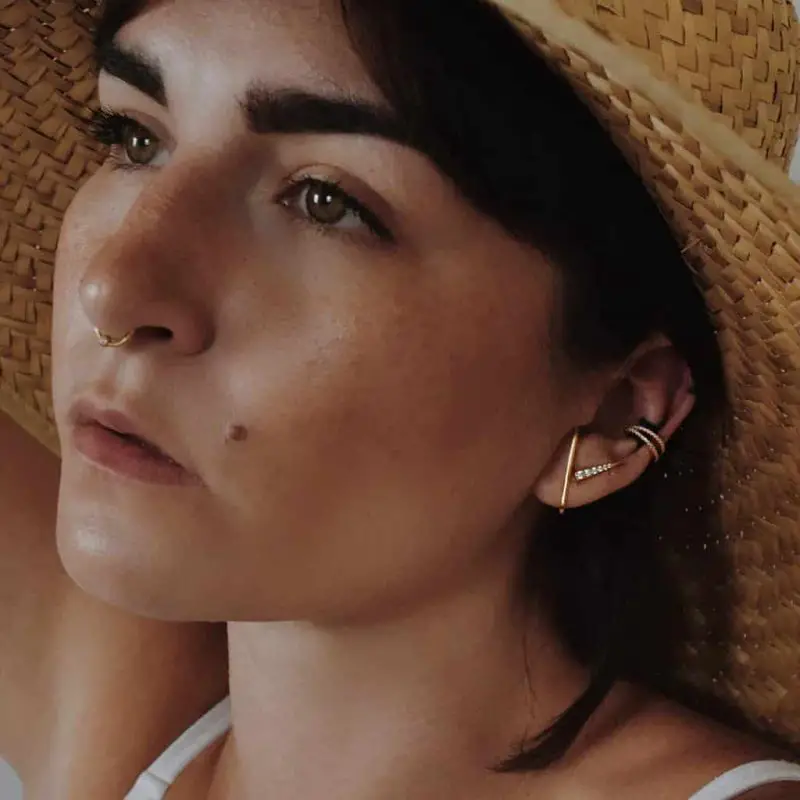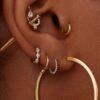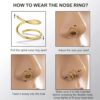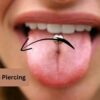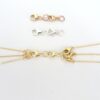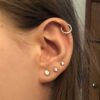Nose Piercing
Do Septum Piercings Close? Everything You Need to Know Before Getting One
One prevalent inquiry regarding septum piercings is whether they eventually close up. This is a valid concern, especially if you are planning to get one or already have one. You might want to know how long you can keep your septum piercing out, or if you can ever get rid of it completely.
The answer to this question is not simple, as it depends on many factors, such as how long you have had your septum piercing, how well it has healed, what kind of jewelry you wear, and how often you change or remove it. There is also a lot of misinformation and myths about septum piercings that can confuse you even more.
That’s why we created this guide to clear up all your doubts about septum piercings and their closure. In this guide, you will learn everything you need to know about this topic, including:
- The science behind septum piercings and how they are done
- The factors that affect septum piercing closure and how quickly it can happen
- How to prevent a septum piercing from closing and what to do if you have to take it out
- How to re-open a septum piercing if it closes and when to consider re-piercing
- The common myths about septum piercings and the best aftercare practices
- The signs your septum piercing might be closing and how to deal with them
- The pros and cons of getting a septum piercing and why respect for the piercing is crucial
By the end of this guide, you will have a clear understanding of what septum piercings are, how they work, and what to expect from them. You will also be able to make an informed decision about whether or not a septum piercing is right for you.
Septum piercings, located in the cartilage separating the nostrils, do have the potential to close if the jewelry is removed. The speed at which they close can vary based on factors like how long you’ve had the piercing and individual healing rates. Generally, a newer septum piercing will close more quickly, sometimes within a few hours, while a fully healed septum piercing may take weeks or even longer to close up.
Contents
- 1 History of Septum Piercings
- 2 The Science Behind Septum Piercings
- 3 Factors that Affect Septum Piercing Closure
- 4 How Quickly Will A Septum Piercing Close?
- 5 Factors That Influence Closure Speed
- 6 How Can You Prevent A Septum Piercing From Closing?
- 7 What Should You Do If You Have To Take A Septum Piercing Out?
- 8 Can You Re-Open A Septum Piercing If It Closes?
- 9 Common Myths about Septum Piercings
- 10 Best Aftercare Practices
- 11 Signs Your Septum Piercing Might Be Closing
- 12 Re-Piercing a Septum: Things to Consider
- 13 Why Respect for the Piercing is Crucial
- 14 FAQs
- 15 Conclusion
History of Septum Piercings
Long before septum piercings graced the noses of fashion-forward individuals in bustling urban streets, they held a sacred place in many ancient cultures. From the warrior tribes of Papua New Guinea to the spiritual shamans of Central America, septum piercings were not just decorative but symbolized strength, courage, and passage into adulthood. While in today’s world, a septum piercing may be seen as a trendy accessory or a bold fashion statement, it’s humbling and fascinating to recognize its ancient roots and deep cultural significance.

The Science Behind Septum Piercings
Now, diving into the nitty-gritty of the topic, let’s discuss the science behind septum piercings.
How Piercings Heal
When you puncture the skin, the body goes into immediate repair mode. Imagine a tiny construction site with proteins and cells rushing in to heal the wound. The body’s natural healing process is a marvel in itself. Within the first few days, a protective barrier forms around the piercing, shielding it from harmful bacteria. This is your body’s first line of defense.
However, not all piercings are the same. The septum, the thin wall between your nostrils, is a mix of cartilage and soft tissue. And here’s a fun fact: when you get your septum pierced, it’s often the soft tissue, not the cartilage, that’s being punctured. This is one of the reasons why many find septum piercings less painful than other cartilage piercings. But this also means the healing process and aftercare for septum piercings might differ from that of, say, a helix piercing.
Factors that Affect Septum Piercing Closure
Several factors can influence how a septum piercing heals and whether it closes up if you remove the jewelry.
Time the piercing has been in place:
A fresh piercing is more likely to close up faster than one that’s been in place for years. Think of it like a new friendship; the longer you nurture it, the stronger it becomes.
Individual body reactions:
We’re all unique. Some of us heal faster, while others might take a bit longer. Factors like age, overall health, and even genetics can play a role in the healing process.
Aftercare and piercing cleanliness:
Just like you wouldn’t neglect a plant you just got, a piercing also requires care. Regular cleaning, avoiding unnecessary touching, and keeping it free from contaminants can not only speed up healing but also prevent unwanted closure.
How Quickly Will A Septum Piercing Close?
“You know, back when I first got my septum pierced, one of the questions that kept nagging me was – if I ever took it out, would it close up immediately?” The answer isn’t as straightforward as one might think.
Variations Among Individuals
Each of us is a unique blend of genetics, habits, and health, which means our bodies react differently to piercings. While I have friends whose septum piercings started closing within hours of removing their jewelry, others have had the luxury of leaving theirs out for weeks without much change.
Factors That Influence Closure Speed
Beyond individual differences, other factors play a role:
Age:
Younger individuals tend to heal faster than older folks. Remember how quickly you used to recover from scrapes as a kid? The same principle applies here.
Health & Lifestyle:
A healthy diet, regular exercise, and proper hydration can promote faster healing. On the flip side, habits like smoking can slow the process down.
How Can You Prevent A Septum Piercing From Closing?
Now, if you’re fond of your septum piercing, here are some tips to ensure it doesn’t close up on you.
Maintenance Routines
Consistency is key. Clean your piercing regularly with saline solution, avoid touching it with dirty hands, and be gentle when you do. This will keep the pierced area healthy and lessen the chances of it closing prematurely.
Jewelry Selection and Adjustments
Wearing the right kind of jewelry can make a difference. Opt for hypoallergenic materials like titanium or surgical steel to prevent reactions. And if you’re planning to leave your piercing jewelry-free for a while, consider tapering or gradually reintroducing jewelry to keep the hole open.
What Should You Do If You Have To Take A Septum Piercing Out?
Maybe it’s for a job interview or a medical procedure, or perhaps you’re just rethinking the piercing altogether. Here’s what you should do:
Step-by-Step Removal Guide
- Cleanse Your Hands: Always start with clean hands. Use antibacterial soap.
- Loosen the Jewelry: If it’s a circular barbell, hold each end and rotate gently. If it’s a captive bead ring, you might need ring-opening pliers.
- Remove Slowly: Slide the jewelry out gently, ensuring not to tug or pull harshly.
- Clean the Area: Use a saline solution to clean the pierced area.

When to Consult a Professional
If you’re struggling to remove the jewelry or if there’s swelling, pain, or signs of infection, it’s essential to consult your piercer or a medical professional.
Can You Re-Open A Septum Piercing If It Closes?
This is a common concern. “I once took out my septum ring for a week, and when I tried to put it back, it felt like it had shrunk! Was it closed? Could I reopen it?” Let me shed some light on this.
Professional Interventions
Sometimes, even if a piercing seems closed from the outside, there might be a partial opening internally. In such cases, a piercer can use a taper to reopen or widen the hole. However, always approach a professional for this; DIY efforts can lead to injury or infection.
Risks and Precautions
While reopening a closed piercing is possible, it does come with risks. There’s the possibility of creating scar tissue, leading to a lump or bump. Infections and complications are also concerns. Always ensure you’re in the hands of a reputable professional and follow their guidance diligently.
Common Myths about Septum Piercings
Ever heard someone say, “Don’t get a septum piercing; it’ll make you sneeze non-stop!” or “You can’t ever get an MRI with that thing in your nose!”? Let’s address some of these wild misconceptions together.
Debunking Misconceptions
- Septum Piercings Affect Your Breathing: False. The piercing is done on the soft tissue below the nasal cartilage, not anywhere that would obstruct airflow.
- It’s the Most Painful Piercing: Pain is subjective, but many find septum piercings less painful than other facial piercings because they go through a thin piece of soft tissue.
- You Can’t Hide a Septum Piercing: Wrong! With a retainer or by simply flipping certain jewelry up into the nostrils, it’s completely concealable.
Setting the Record Straight
You see, everybody’s modification has its fair share of myths. But knowledge is power. Always consult a professional, and don’t let baseless myths dictate your choices.
How to Ensure Proper Healing
“I remember when I got my septum pierced; my biggest concern was the healing process. Will it get infected? What if I accidentally bump it?” Healing is a journey, and here’s how you can ensure a smooth one:
Best Aftercare Practices
- Cleaning Solutions: Use a saline solution (a mixture of salt and water) to clean your piercing. It’s gentle and effective. Avoid alcohol or hydrogen peroxide as they can be too harsh and delay the healing process.
- Recommended Daily Care Routines: Clean your piercing at least twice a day, especially after activities that make you sweat. Rotate the jewelry gently while cleaning to ensure the solution reaches inside.
What to Avoid
- Activities: Swimming in public pools or hot tubs can expose your piercing to bacteria.
- Substances: Alcohol-based products or those with added fragrances.
- Conditions: Extreme cold can cause metal jewelry to contract, which might be uncomfortable.
Signs Your Septum Piercing Might Be Closing
“Once, I left my septum jewelry out longer than intended. Panic set in as I wondered: is it closing?” Here’s what you should look out for:
- Physical Changes: The hole appears smaller or skin seems to be growing over the opening.
- Sensations or Feelings: A resistance or slight pain when trying to reinsert jewelry can be indicative of closure.
Re-Piercing a Septum: Things to Consider
Contemplating getting your septum re-pierced? “I’ve been there!” Here are some things you might want to think about:
- The Anatomy of Scar Tissue: Scar tissue is tougher than regular skin. Re-piercing through it can be more painful and might take longer to heal.
- Professional Consultations: Always consult with a professional piercer. They can assess the condition of the previous piercing site and provide guidance on the best way forward.
Why Respect for the Piercing is Crucial
If you’ve ever met someone with a septum piercing, you might’ve wondered, “What’s the story behind that?” Or perhaps you’re the one sporting that piercing. Either way, every piercing tells a tale, and respecting it is about acknowledging both its emotional and physical impacts.
The Emotional Attachment
Having pierced my septum years ago, I can vouch for the deep emotional connection it often fosters.
- Personal stories and significance: For many, septum piercings aren’t just about aesthetics. They can be symbolic of a personal journey, a rite of passage, or even an act of self-expression.
- The beauty in individual expression: Septum piercings defy conventional beauty standards. They teach us to find beauty in uniqueness and to value our individual journeys. And isn’t that what life’s about?
Our Other Septum Piercing Guide
- Septum Piercings
- Types of Septum Rings
- How To Clean A Septum Piercing
- Small Septum Piercing
- Septum Ring Sizes
- Septum Piercing on Men
- How Much Does a Septum Piercing Cost
FAQs
How long does it take for a septum piercing to fully heal?
Typically, septum piercings take 6 to 8 weeks to heal. However, everyone’s body is different, so always consult with your piercer.
Can I re-pierce my septum if it closes?
Yes, in many cases, you can. However, it’s essential to consult with a professional piercer to assess the area and guide you on the best course of action.
What are the risks associated with septum piercings?
Some risks include infection, incorrect placement, and potential development of scar tissue.
How can I tell if my septum piercing is infected?
Signs include redness, swelling, a warm sensation, yellow or green discharge, or persistent pain. If you suspect an infection, see a healthcare professional immediately.
Do septum piercings leave visible scars?
Typically, septum piercings leave minimal to no scarring. However, this can vary depending on individual healing, the piercing’s care, or complications that may arise.
How long do septum piercings take to close?
Septum piercings can start to close in as little as a few hours to several days, especially if they’re relatively new. For piercings that have been in place for years, the closure process might be slower, but it varies from person to person.
Will my septum hole close if I take it out?
Yes, the septum hole can close if you take out the jewelry, particularly if the piercing is new. The timeframe for closure varies, with newer piercings closing faster than older, more healed ones.
Are septum piercing holes permanent?
While septum piercings can leave a small hole or dimple, it’s often not noticeable unless you’re looking for it. Over time, even longstanding piercings can close to the point where jewelry insertion becomes difficult without professional help.
How do you reopen a closed septum piercing?
Reopening a closed septum piercing should be done by a professional piercer to prevent injury and reduce the risk of infection. They’ll assess the tissue and use specialized tools to safely reinsert jewelry.
Will my septum piercing close up overnight?
For newer piercings, there’s a risk that the septum piercing can start to close overnight. If the piercing is well-healed and has been in place for a long time, the risk is lower but still exists.
Do septum piercings close after years?
Even after years, a septum piercing can close, especially if jewelry has been removed for an extended period. However, the speed at which it closes varies, with some individuals finding their piercings remain open for longer durations without jewelry.
Conclusion
As we journeyed through the world of septum piercings, from its history to the science behind its healing, one thing remains clear: It’s more than just a piercing. Whether you’re contemplating getting one or already have one, remember that it’s a statement, a commitment, and a piece of art all in one. Always make informed decisions, and treasure the beauty of individual expression.
Resources

Camila Luna is a passionate jewelry enthusiast and content creator at Miami Jewelry Co. With a focus on providing high-quality, Miami-style jewelry, Camila and her team specialize in a wide range of jewelry that includes bracelets, necklaces, earrings, and more
